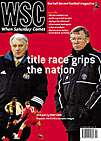 For day 12 of the WSC advent calendar we’re looking at on of the gifts given to baby Jesus; gold. In April 2002, issue 182, Bobby McMahon attempted to explain why South Korea took part in that year’s Concacaf Gold Cup and suggested a way to put the tournament out of its misery
For day 12 of the WSC advent calendar we’re looking at on of the gifts given to baby Jesus; gold. In April 2002, issue 182, Bobby McMahon attempted to explain why South Korea took part in that year’s Concacaf Gold Cup and suggested a way to put the tournament out of its misery
On the world football scale, winning the Gold Cup is tantamount to winning the world’s tallest midget competition. Not only is it contested by teams from one of the weakest regions, Concacaf, it receives minimal fan support and attracts almost no media interest. Ostensibly created in 1991 to help promote the 1994 World Cup in the US as well as to help the home country’s preparations, the competition replaced the Concacaf Championship which had been contested under various formats and with a varying number of participants since 1941. Costa Rica dominated until 1989 with ten wins, while the Mexicans, who you would have perhaps expected to lead, won only three.
After the success of the 1994 World Cup, Concacaf was intent on ensuring a professional soccer vacuum didn’t occur in the United States. MLS was experiencing tremendous difficulties getting off the ground and the continuation of the Gold Cup appeared to offer a decent alternative. The decision was made to play the tournament every two years starting in 1996, and that alone ensured that the Gold Cup would never amount to much. A summer tournament was no longer possible because of a conflict with the World Cup finals and so the date moved to January and February.
The timing of the decision also coincided with a growing trend of players from Concacaf to move to European leagues. This guaranteed an ongoing source of friction between the clubs, players and national associations. This time around Canada, Costa Rica and Trinidad & Tobago asked for players to be released, while others didn’t take the tournament too seriously. Mexico sent a reserve squad, the hosts US almost exclusively used MLS players and Ecuador looked thoroughly uninterested, while Korea’s coach Guus Hiddink constantly changed his team.
Astute readers will have noticed that South Korea and Ecuador are not Central American, North American or Caribbean counties. Since its inception in 1991 the Gold Cup has invited guest teams to compete, not something that lends credibility to the competition. It’s simple: when you invite outside teams to enter a regional championship it’s no longer a regional championship. Can anyone imagine Europe inviting Brazil, Argentina and Cameroon to fly in for a game or two? In the past we’ve seen Peru, Colombia and Brazil turn up, along with South Korea and Ecuador. To date no guest has won the Cup but two have reached the final.
The move to a winter format has also proved disastrous for attendances. To have any hope of attracting decent crowds, the Gold Cup needs Mexico to do well. In a perfect financial world they would face the US in the final, an outcome we saw in 1993 and 1998. In 2000 both went out in the quarter-finals while Colombia and Canada met in the final before a crowd that would have embarrassed Brechin City.
This time around only Mexico drew well in the early stages, and after they lost in the quarter-finals to South Korea attendances dropped dramatically. Despite the US reaching the final, where they beat Costa Rica 2-0, the last four games in the competition attracted fewer than 22,000 fans. Cup organisers were quick to point out that the Cup was up against the National Hockey League all-star game and the Superbowl weekend. They were not so quick to explain why they had scheduled the Cup against these events in the first place.
The problems facing the Gold Cup are strikingly similar to those facing the Copa America. Both tournaments have trouble attracting full strength teams, both hold their competition every two years and both invite outsiders. With ten member countries, the South American federation Conmebol has to invite two guest nations in order to get to a workable number. Honduras, Mexico, Japan, the US and Costa Rica have all taken part in recent years. There is, however, a solution – the Pan American Cup, a 16-team tournament staged every four years, between World Cups, with no guest teams. With the imminent demise of the ill-fated and vastly unpopular Confederations Cup, the need to identify regional champions no longer exists.
Is there hope that Conmebol and Concacaf would give up some of their power and merge the two troubled competitions? Concacaf run a tournament of no value, so they have little to lose. Conmebol’s view is likely to be different since the Copa America is the world’s oldest international tournament. However, FIFA have already told the South Americans that an 18-game World Cup qualifying group can’t continue if the Copa America is held every two years. The World Cup games generate tremendous interest and a great deal of money which Conmebol cannot afford to lose. The alternatives are to change the Copa America to a four-year format or make a bold move. Unfortunately, here as elsewhere in world football politics, moves that are both smart and bold are in short supply.
From WSC 182 April 2002. What was happening this month